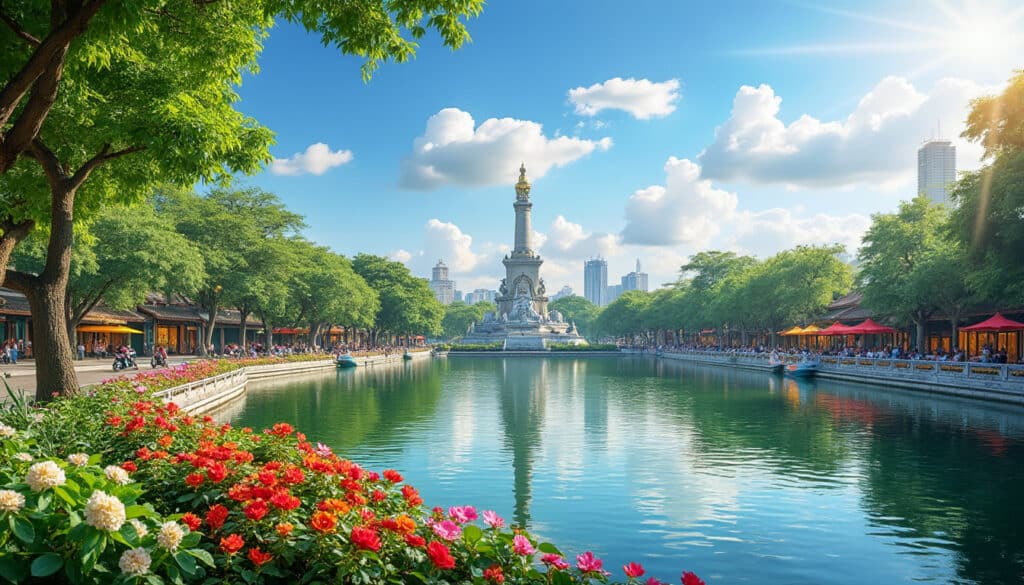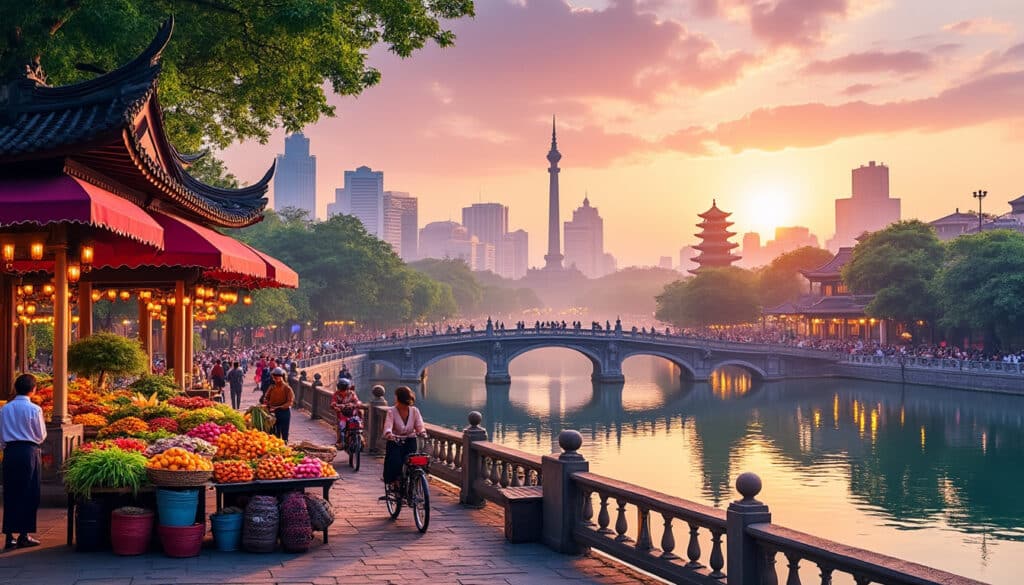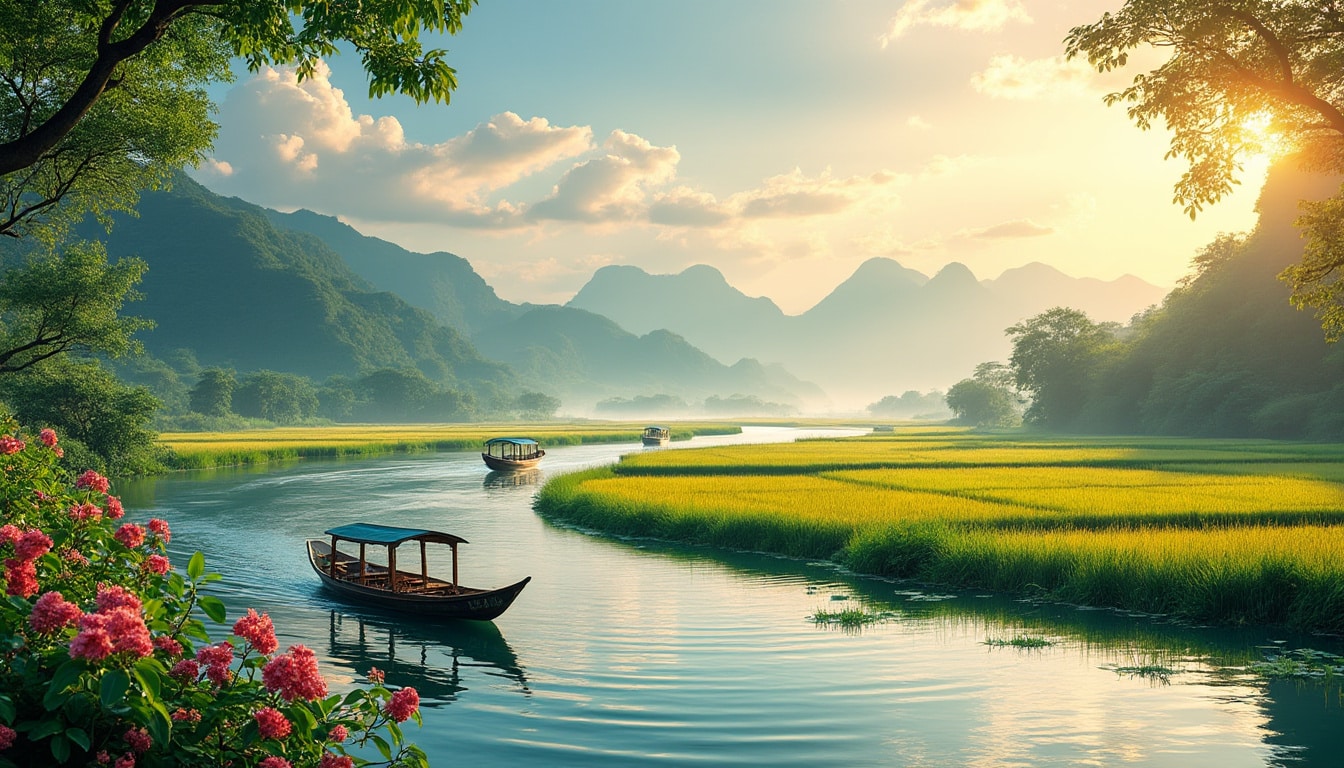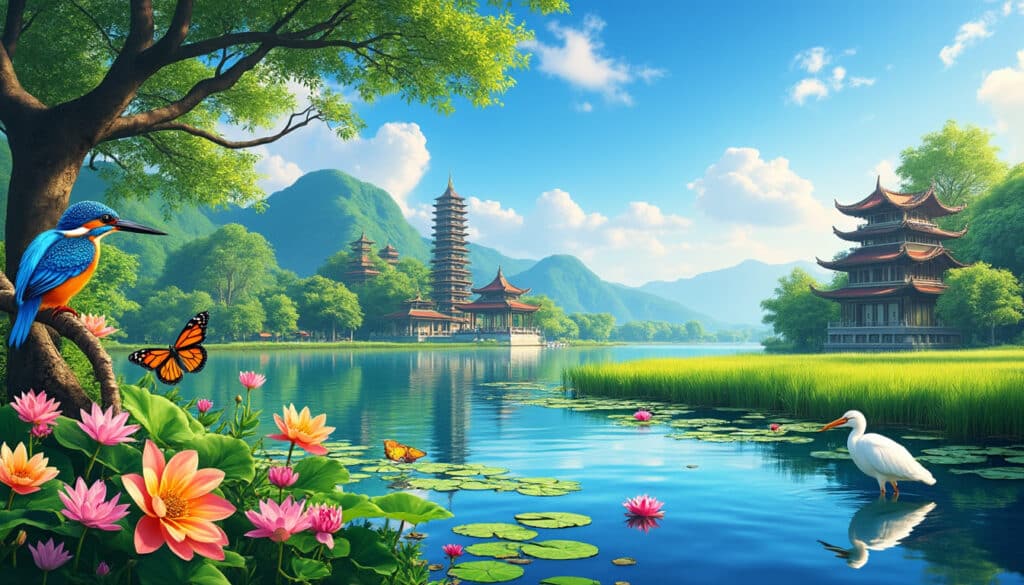Hanoi, a city known for its rich history and vibrant culture, is intricately woven with a network of rivers that play a significant role in its geography and daily life. These rivers not only provide resources but also contribute to the city’s unique charm. From ancient waterways like the Red River that has shaped the city’s landscape over centuries to the smaller streams and lakes that dot the urban landscape, water is an essential element of Hanoi’s identity.
The Red River: Hanoi’s Lifeline
Spanning an impressive 1,149 kilometers, the Red River, known locally as the Sông Hồng, is not just a geographical feature; it’s a cultural icon for Hanoi and northern Vietnam. Originating in Yunnan, China, it flows through several provinces before reaching Hanoi, and then ultimately empties into the Gulf of Tonkin. Within the city’s precincts, the river traverses various districts including Ba Vì, Tây Hồ, and Long Biên, contributing to the fertility of the land and the prosperity of its people.
The Red River’s significance extends beyond mere geography. It serves as a vital resource for agriculture, thanks to its nutrient-rich silt deposited in the delta, fostering Vietnam’s renowned rice cultures. The river is also pivotal for transportation, where services like Red River Rafting Co. and Hanoi River Expeditions offer unique experiences for locals and tourists alike. Despite its benefits, the river poses challenges too, such as flooding during the monsoon season, pushing residents and authorities to maintain high vigilance. You can read more about how the floods impact Hanoi.
- Length: 1,149 km 🌊
- Origins: Yunnan, China 🌏
- Key Districts in Hanoi: Ba Vì, Tây Hồ, Long Biên 🏞️
The Red River’s cultural significance is profound, often depicted in Vietnamese literature and music. It’s a symbol of life, resilience, and continuity, echoing through generations. This river isn’t merely a waterway; it’s a testament to Hanoi’s historical evolution and its enduring spirit.

Harnessing the Red River: Modern Applications
In modern times, the Red River is harnessed for various urban needs. Projects like the “Nước sạch sông Đà” supply clean water to vast areas of Hanoi, illustrating how these ancient rivers continue to sculpt contemporary life. Furthermore, the river supports a burgeoning ecotourism industry with activities such as kayaking and river cruises offered by companies like Thang Long River Cruises and Nhat Tan Water Tours, enhancing its economic and recreational value. For more insights, explore how these rivers shape Hanoi’s geography.
Song Da: Hanoi’s Energy Source
The Song Da, a major tributary of the Red River, contributes significantly to Hanoi’s water supply and energy production. Stretching over 927 kilometers, this river originates in China and is characterized by its challenging rapids and extensive hydropower potential. Notably, it supplies over 30% of the Red River’s water, underscoring its vital role in the region’s ecological and economic systems.
Hanoi’s reliance on the Song Da for energy is exemplified by the construction of several large dams, including the Hòa Bình and Sơn La. These projects not only generate electricity but also manage water distribution, critical during dry seasons. This facet of Song Da highlights its title as the “Energy River.”
| Key Dam Projects | Purpose | Location |
|---|---|---|
| Hòa Bình Dam ⚡ | Electricity Generation | Hòa Bình Province |
| Sơn La Dam 🌿 | Irrigation & Electricity | Sơn La Province |
| Lai Châu Dam 🚧 | Flood Control & Power | Lai Châu Province |
With significant hydropower facilities, Song Da is instrumental in Hanoi’s sustainable energy initiatives. This makes it a crucial asset for both environmental conservation and developmental agendas. The integration of this river into the urban framework exemplifies how traditional resources can be innovatively adapted to meet modern demands, paving the way for future initiatives in sustainable urban planning.
The Hidden Waters of Hanoi: Smaller Rivers and Lakes
Besides its major rivers, Hanoi is punctuated by several smaller streams and lakes, each with unique ecological and cultural roles. The Sông Tô Lịch, for instance, meanders through the city’s core but is unfortunately plagued by pollution, earning it the moniker “dead river.” Efforts are underway to clean and rejuvenate this waterway, reflecting Hanoi’s commitment to environmental restoration.
Other notable mentions include the tranquil Lotus Lake Adventures on West Lake, providing serene backdrops for both relaxation and festive activities. These water bodies are crucial to Hanoi’s biodiversity, often serving as habitats for various flora and fauna.
- Lake of the Restored Sword (Hoàn Kiếm) ⚔️
- West Lake 🌞
- Truc Bach Lake 🌼
Ecological Impact and Conservation Efforts
To address the ecological challenges facing these waters, Hanoi is investing in numerous conservation projects. Perfume River Eco Tours is an example of an initiative that not only promotes environmental awareness but also generates income through sustainable tourism practices. Hanoi’s strategy includes balancing growth with green spaces, ensuring that its natural beauty is preserved for generations to come. Discover how local geography contributes to this conservation on Hanoi’s geographical features.
The Economics of Hanoi’s Waterways
The waterways of Hanoi are not just scenic wonders; they are integral to the city’s economy. From fishing and agriculture to tourism and renewable energy, water is a cornerstone of Hanoi’s economic landscape. Companies like Blue Dragon Kayaking and Yangtze River Expeditions stimulate the local economy through innovative water-based activities. These enterprises offer adventurous options for exploring Hanoi’s intricate river systems.
In terms of agriculture, the fertile soil created by the rivers’ sediment is invaluable. Wet rice cultivation heavily relies on these natural resources, supporting not just local consumption but also contributing to export revenues.
| Economic Activities | Rivers Involved | Benefits |
|---|---|---|
| Fishing 🎣 | Red River, Song Da | Livelihoods & Food Supply |
| Agriculture 🌾 | Red River | Food Production & Exports |
| Tourism 🚣 | Red River, West Lake | Economic Growth & Jobs |
Efforts to maintain and enhance these economic benefits include infrastructural developments and environmental sustainability initiatives. Emphasizing clean water, infrastructure, and sustainable practices is critical for perpetuating prosperity in Hanoi’s water-dependent economic sectors. For more on the legal aspects of these initiatives, visit Hanoi’s regulations.
Rivers as Cultural Vessels in Hanoi
The rivers of Hanoi are more than mere physical entities; they are custodians of tradition and culture. Each river tells a tale of the past and continues to shape the lives and traditions of Hanoi’s residents. For instance, the Sông Nhuệ and Sông Tô Lịch are steeped in local folklore, often associated with ancient Vietnamese myths and legends. These rivers appear in poetry, giving insights into the social and historical contexts of different eras.
In Hanoi, water festivals are common, where these rivers serve as venues for communal gatherings and celebrations. Events like boating races and cultural performances are held frequently, making these waters vibrant stages for community bonding and cultural expression. Such events are part of the city’s soul, embodying both heritage and modernization.
Community and Traditions
From rural traditions to urban gatherings, Hanoi’s rivers are central to community life. They provide a common thread that unifies people across different neighborhoods. Such traditions are reflected in services like Mekong Waterway Adventures, which offer cultural insights through explorative river tours. Embracing these waterways is crucial for fostering communal strength and cultural continuity in an ever-evolving urban environment.
- Dragon Boat Festival 🐉
- Mid-Autumn Celebrations 🌕
- Lunar New Year Water Parades 🥳
The cultural integration of Hanoi’s rivers into everyday life is a testament to their unwavering significance. As Hanoi evolves, its rivers continue to serve as channels of history, tradition, and community flow, captivating both residents and visitors alike.
FAQs about Rivers Near Hanoi
Below are some frequently asked questions to assist you in understanding the importance of Hanoi’s rivers.
- Are the rivers in Hanoi safe for water sports? 🌊
Yes, many parts are safe for activities like kayaking and cruises, especially where services like Hanoi Watersports operate. - How does the government manage pollution in Hanoi’s rivers? 🏞️
Efforts include water treatment initiatives and ecological tour programs to raise awareness and reduce pollution. - Can tourists access the Red River for tours? 🚤
Absolutely, with companies like Nhat Tan Water Tours providing guided experiences along the river. - What is the best time to visit Hanoi’s rivers? 🗓️
The most favorable time to explore is during the dry months from November to April when water levels are optimal for various activities. - Are there any cultural festivals held near the rivers? 🎉
Yes, many festivals like the Dragon Boat Festival and Mid-Autumn Celebrations highlight these waterways, offering vibrant insights into local customs.

Hanoi, the vibrant capital of Vietnam, is renowned for its rich cultural heritage and delectable street food. Yet, beneath the bustling streets and amidst the ancient architecture, lies an often-overlooked facet of the city—its astounding natural beauty and geographical diversity.…

Geographical features of Hanoi
Hanoi, a city where history and geography dance gracefully together, offers an alluring canvas of diverse landscapes and cultural facets. Tucked in Northern Vietnam’s Red River Delta, Hanoi thrives as a bustling hub of Vietnamese heritage and modern innovation. The…

Location and coordinates of Hanoi
Hanoi, the bustling capital of Vietnam, is a city where history and modernity blend seamlessly. Its geographical location plays a significant role in defining not only its cultural identity but also its strategic importance in Southeast Asia. Nestled in the…


